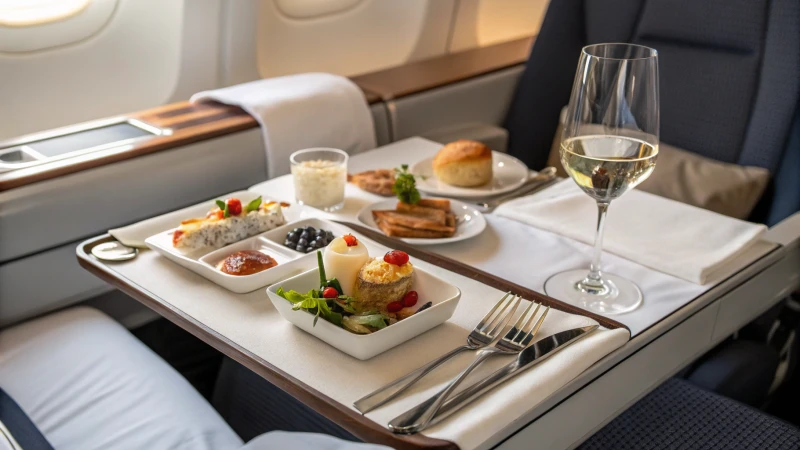
Ever wondered how the simple choice of tableware could transform your in-flight meal experience and save money?
By opting for lightweight, eco-friendly tableware, airlines not only elevate passenger dining experiences but also cut operational costs. Materials like biodegradable disposables reduce fuel use and minimize cleaning expenses, aligning with sustainability goals and improving brand reputation.
You know, when I first learned about the impact of tableware on airline operations, it was like discovering a secret recipe for success. Imagine reducing fuel consumption just by using lighter cutlery! It’s like when I switched to a lighter backpack for my daily commute—suddenly, my back didn’t hurt anymore, and I got to enjoy the walk.
Airlines are doing something similar by choosing materials that are both feather-light and biodegradable. This not only reduces the weight of the plane (cutting down fuel costs) but also saves on cleaning expenses. Picture this: less time spent scrubbing dishes means more resources can go towards improving passenger experiences. And let's not forget how eco-friendly options boost the airline's image, making passengers feel good about their choice to fly green.
Each flight is an opportunity for airlines to weave these tiny adjustments into a grand tapestry of sustainability and efficiency. Just as I’ve embraced eco-friendly changes in my life, airlines can do the same, creating a ripple effect that benefits both the planet and their bottom line.
Lightweight tableware reduces airline fuel costs.True
Using lightweight materials decreases the overall weight, saving fuel.
Eco-friendly tableware increases cleaning expenses.False
Eco-friendly options often reduce costs by being disposable, lowering cleaning needs.
What Makes the Best Material for Airline Tableware?
Choosing the right airline tableware material feels like balancing on a tightrope, weighing efficiency, eco-friendliness, and the passenger's in-flight experience.
Biodegradable plastics, lightweight metals like aluminum, and compostable wood are top materials for airline tableware. They offer durability, reduce aircraft weight, and support sustainability goals, ultimately boosting passenger satisfaction.
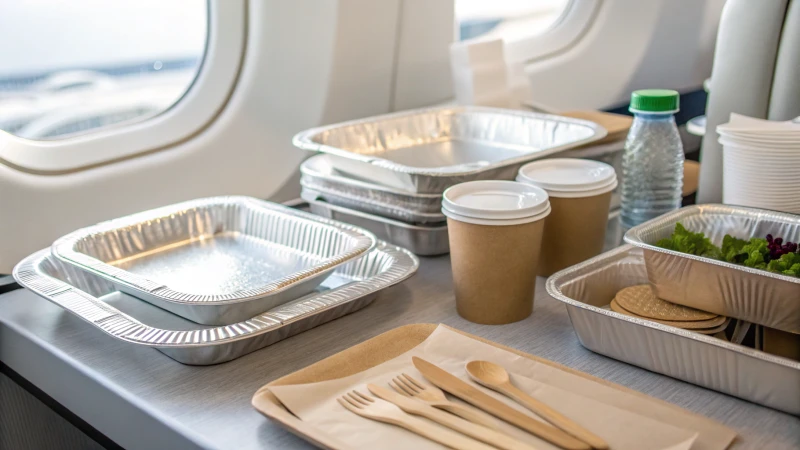
Diving into Material Choices
When I think about airline tableware, it reminds me of my first flight as a kid—torn between the excitement of flying and the curiosity about how everything worked, including the meal trays! As an adult, I see that the choice of materials is like a behind-the-scenes hero in this experience. Let's explore some of the materials that have made a significant impact in the industry.
| Material Type | Benefits | Considerations |
|---|---|---|
| Biodegradable Plastics | Lightweight, reduces fuel costs, eco-friendly | Potentially higher costs, disposal logistics |
| Lightweight Metals | Durable, reusable, maintains heat | Requires cleaning and maintenance |
| Compostable Wood | Fully biodegradable, aesthetic appeal | Limited durability, cultural acceptance may vary |
Biodegradable Plastics
It’s fascinating how biodegradable plastics have taken center stage, offering a lightweight1 alternative that's easy on the planet. Imagine these materials breaking down naturally; it aligns with our eco-conscious world. But I know airlines face challenges with upfront costs and creating effective disposal systems.
Lightweight Metals
Then there's aluminum—a go-to for its durability and sleek look. On long flights where you need reliability, these metals are a solid choice. Cleaning might be more frequent, but when you think about the reusability factor, it offsets costs over time.
Compostable Wood
I personally love the rustic feel of wooden cutlery. It not only resonates with eco-minded travelers but also adds a charming touch to in-flight dining. Although not as durable as metal or plastic, its customization potential2 can be a branding dream come true for airlines.
Ultimately, choosing the right material is a balancing act of operational demands and passenger expectations. It’s about knowing your audience—whether it’s a long-haul international flight or a short domestic hop—and tailoring the tableware accordingly. It's amazing how something so simple can make such a difference.
Biodegradable plastics reduce airline fuel costs.True
Biodegradable plastics are lightweight, thus reducing overall aircraft weight and fuel consumption.
Compostable wood is more durable than metals.False
Compostable wood has limited durability compared to metals, which are more robust and reusable.
How Does Tableware Design Impact Passenger Experience?
Imagine savoring your in-flight meal with tableware that doesn't just serve food, but elevates the whole experience. Intrigued? Let's dive in!
Tableware design impacts passenger experience by enhancing meal presentation, comfort, and cultural connection, while aligning with sustainability goals. Well-designed tableware supports service efficiency and adds to the overall ambiance.
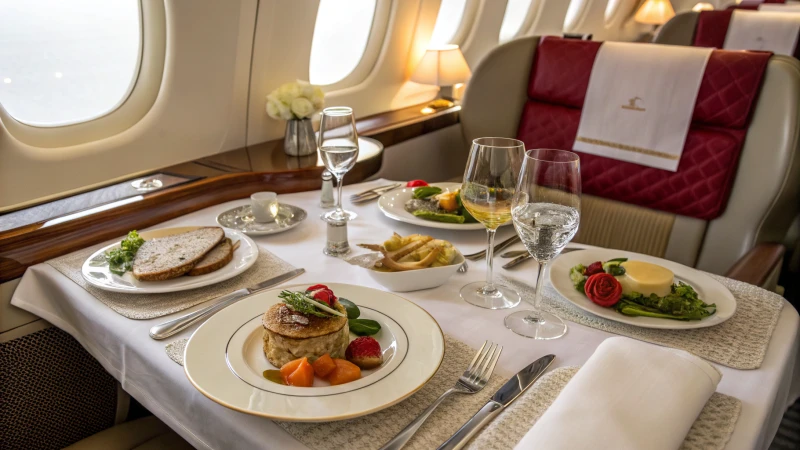
Enhancing Meal Presentation
Think about the last time you were on a flight, and how a beautifully presented meal could have made all the difference. Airlines are increasingly investing in tableware that doesn't just hold food but transforms meals into culinary experiences. I remember flying business class once and being utterly charmed by the elegant, minimalist tableware that made my meal feel like dining at a high-end restaurant. This attention to detail helps airlines not only enhance meal enjoyment but also carve out a distinctive brand identity. Visual appeal3 in tableware is key to creating these memorable moments.
Comfort and Usability
Imagine trying to enjoy a meal during turbulence—it's already stressful enough without worrying about spills! I've been on flights where the ergonomic design of cutlery made all the difference. It's not just about looks; practical designs that fit comfortably in your hand can significantly enhance passenger satisfaction. Airlines must also consider passengers with limited mobility or diverse cultural dining habits to ensure everyone has a comfortable experience.
Cultural Connection
The thrill of flying to a new destination can be beautifully mirrored in the tableware design itself. I once flew to Japan and was enchanted by the bamboo-patterned cutlery that hinted at where I was headed. Such cultural touches enrich the travel experience, providing a sense of connection even before you land. Cultural elements4 in tableware can make these experiences truly special.
| Aspect | Impact |
|---|---|
| Aesthetics | Enhances visual appeal and meal enjoyment |
| Usability | Increases comfort and reduces spillage risk |
| Culture | Creates a sense of connection and uniqueness |
Sustainability Considerations
In today's world, sustainability isn't just a buzzword—it's a demand. I remember feeling particularly good about choosing an airline that offered biodegradable tableware. It aligns with my values and adds to the airline's image as environmentally conscious. Materials like biodegradable wooden cutlery not only appeal to eco-conscious travelers but also meet growing passenger demand5 for green travel options.
Supporting Service Efficiency
Efficient service is crucial, especially during peak travel times. Well-designed tableware that is stackable or easy to clean can streamline in-flight service, reducing turnaround times and labor costs. I've seen how this leads to smoother service operations, enhancing overall passenger experience. Efficient service6 is vital for maintaining high standards.
By integrating these considerations into tableware design, airlines can significantly enhance the passenger experience while aligning with operational goals and sustainability initiatives. The impact of thoughtful design reaches beyond aesthetics, affecting every aspect of the flight, from meal enjoyment to brand perception.
Sleek tableware design appeals to business-class passengers.True
Business-class passengers appreciate luxury, and sleek designs enhance meal service.
Biodegradable cutlery increases airline labor costs.False
Biodegradable cutlery reduces cleaning needs, potentially lowering labor costs.
How Can Tableware Choices Lead to Cost Savings in Airlines?
Ever thought about how something as simple as the choice of tableware on flights could save airlines big bucks?
Yes, by choosing lightweight and eco-friendly tableware, airlines can significantly reduce costs. These choices help decrease fuel consumption and waste management expenses, all while boosting the airline's green image.
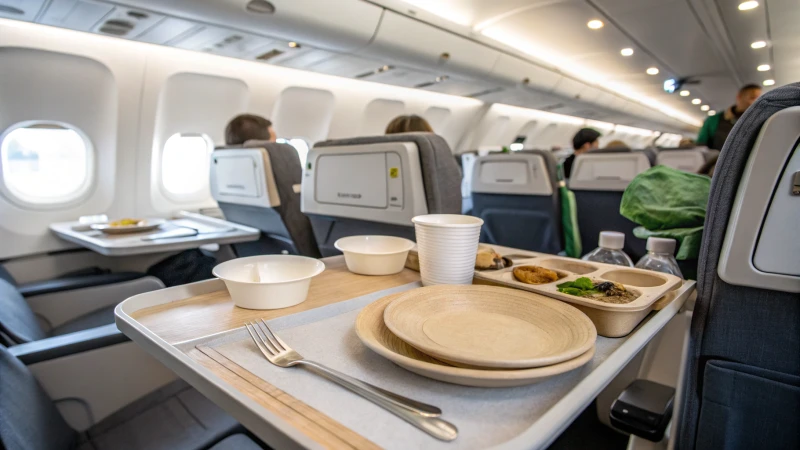
The Impact of Weight on Fuel Efficiency
Imagine this: every time you hop on a flight, the cutlery you use might just be contributing to how much fuel the plane burns. Crazy, right? I remember reading about how airlines switched to lightweight materials like disposable wooden cutlery7. It's incredible to think that something as small as a fork could make such a big difference. When airlines use lighter tableware, they're not just saving on fuel costs—they're also doing their bit for the planet.
Consider a table comparing traditional and modern options:
| Tableware Type | Average Weight per Set | Fuel Cost Impact |
|---|---|---|
| Metal Cutlery | 100 grams | High |
| Wooden Cutlery | 50 grams | Low |
The Role of Eco-Friendly Materials
Switching to biodegradable materials isn't just a trend—it's a commitment. I often think about how making greener choices can affect brand image. Airlines using eco-friendly materials8 appeal to travelers who care about sustainability. It makes me feel good knowing that something as simple as a spoon can reflect a company's values.
Cleaning and Labor Cost Reductions
There was this one time I was on a short-haul flight, and I noticed how fast they turned the plane around. I later learned it's partly because they use disposable tableware, which cuts down on cleaning and labor costs. Not needing to sterilize cutlery means less water and fewer workers needed—a win-win!
Storage and Transport Optimization
Airlines are always looking for ways to save space and cut costs, right? Well, using compact disposable tableware helps with that. It allows for more efficient storage and transport, which means fewer shipments. Imagine reducing logistics costs by 20%-30% just by changing the type of cutlery you use!
Enhancing Passenger Experience
I once flew first class (a rare treat!), and the dining experience was unforgettable. Airlines can customize designs to match their brand9, offering unique experiences for passengers. It’s not just about aesthetics—it’s about creating memories that keep passengers coming back.
Flexibility in Meeting Special Needs
The flexibility of disposable cutlery is another big plus. Airlines can quickly adapt to special occasions or changing demands. It's like having an ace up your sleeve when you need to meet new market trends without delay.
In the end, it’s clear that something as seemingly insignificant as tableware can have a huge impact on an airline's costs and brand perception. By being strategic about these choices, airlines not only save money but also play their part in fostering a sustainable future.
Lightweight tableware reduces airline fuel costs.True
Lighter tableware decreases aircraft weight, reducing fuel consumption and costs.
Eco-friendly materials increase waste disposal costs for airlines.False
Eco-friendly materials reduce waste disposal costs by being biodegradable.
How is sustainability transforming airline catering?
Imagine boarding a flight and knowing your meal supports a greener planet. That’s the magic of sustainability in airline catering.
Sustainability in modern airline catering means using eco-friendly materials, cutting waste, and improving efficiency. Airlines adopt biodegradable cutlery, reduce food waste, and boost fuel efficiency, aligning with global environmental standards.
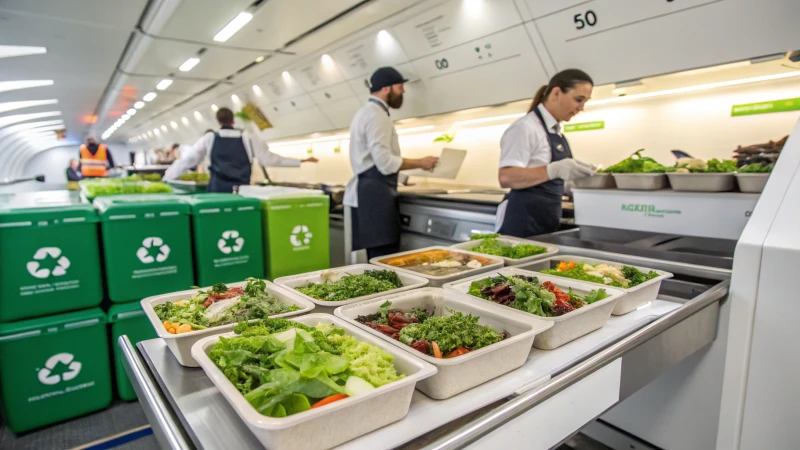
Eco-Friendly Materials: A New Norm
I remember my first encounter with wooden cutlery on a flight. It felt different but satisfying, knowing it was part of a bigger movement towards sustainability. Airlines are embracing biodegradable materials like wooden utensils to cut down on plastic usage. This not only aligns with environmental goals but also offers passengers more sustainable dining choices.
Cost Efficiency Through Weight Reduction
Flying is all about weight management. I learned that replacing metal cutlery with lighter wooden alternatives reduces aircraft weight significantly. This not only cuts fuel costs but also contributes to a more eco-friendly operation. It's fascinating how something as simple as wooden cutlery can have such an impact.
| Material | Weight Reduction (%) | Environmental Impact |
|---|---|---|
| Wooden Cutlery | 50-60% | Fully Biodegradable |
| Metal Cutlery | 0% | High Cleaning Costs |
Waste Management Innovations
On one of my flights, I noticed compost bins being used more prominently, which was a pleasant surprise. Airlines are now adopting compostable products to tackle waste challenges effectively. By focusing on renewable resources and innovative waste processing systems, they’re not just meeting regulations but are part of a larger eco-friendly shift.
- Bio-Based Products: Use of renewable resources promotes a circular economy.
- Waste Processing: Eco-friendly waste disposal10 systems are being integrated into operations.
Enhancing Brand Image
Offering sustainable options isn’t just about compliance; it’s a brand statement. Airlines that prioritize eco-friendly catering enhance their reputation among eco-conscious travelers, creating loyalty and fulfilling the growing demand for green travel.
- Customization: Airlines can design cutlery designs11 to reflect their brand and improve passenger experience.
- Passenger Experience: Options tailored to routes and cultural preferences make flights more enjoyable.
Quick Adaptation to Market Needs
The adaptability of biodegradable cutlery is impressive. Whether it’s a quick domestic hop or a lengthy international flight, airlines can swiftly adjust their supplies to meet demand. This flexibility ensures they stay ahead in the sustainability game.
By embedding these practices into their operations, airlines not only support environmental sustainability but also position themselves as leaders in responsible travel. Embracing these changes is crucial for meeting modern traveler expectations and international sustainability regulations, contributing to a greener future in aviation.
Wooden cutlery reduces aircraft weight by 50-60%.True
Wooden cutlery is significantly lighter than metal, reducing aircraft weight.
Metal cutlery is fully biodegradable.False
Metal cutlery is not biodegradable and has high cleaning costs.
Conclusion
Airlines enhance catering by using lightweight, eco-friendly tableware, reducing fuel costs and cleaning expenses while improving passenger experience and brand image through sustainable practices.
-
Learn how biodegradable plastics can reduce environmental impact and fuel costs in aviation. ↩
-
Explore how customized wooden cutlery enhances airline branding and passenger experience. ↩
-
Exploring this link can provide insights into how visual appeal enhances meal enjoyment and contributes to brand differentiation. ↩
-
Learn about the benefits of incorporating cultural elements into tableware for a more immersive passenger experience. ↩
-
Understand why passengers prefer sustainable travel options and how airlines can meet these expectations. ↩
-
Discover how efficient tableware design supports smoother service operations and reduces operational costs. ↩
-
Learn how lightweight cutlery reduces fuel consumption and operational costs. ↩
-
Discover the benefits of using sustainable materials in aviation. ↩
-
Explore how personalized tableware enhances airline branding and passenger experience. ↩
-
This link provides insights into innovative waste disposal techniques airlines use to enhance sustainability. ↩
-
Explore how airlines use unique cutlery designs to elevate their brand image and passenger experience. ↩

